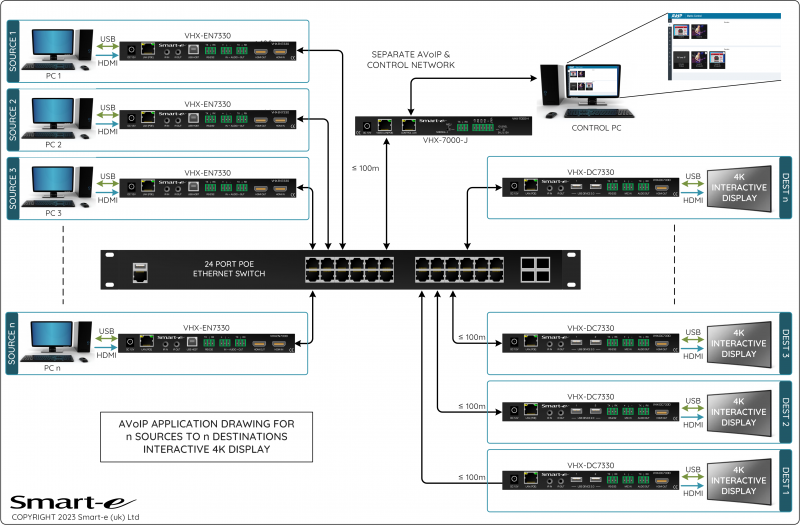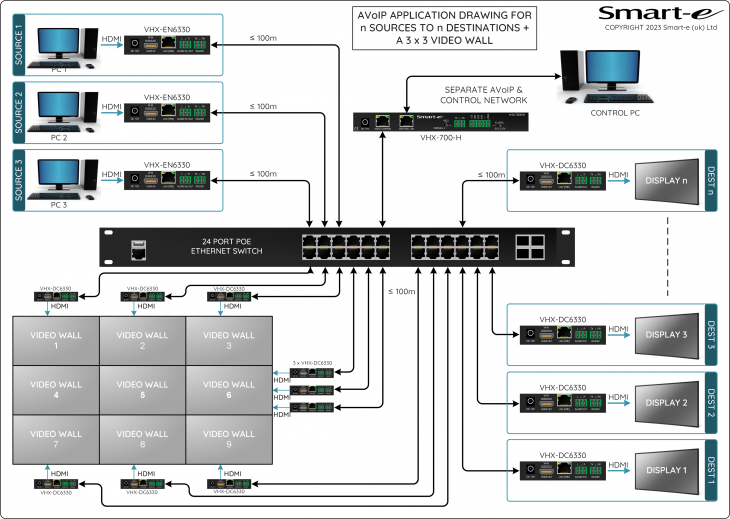AVoIP (Audio-Visual over Internet Protocol)
Background
In recent years there has been a noticeable shift away from using large matrices in a traditional installation towards the use of professional methods of Video Streaming. Whilst this technology has been around for a while and most people will be familiar with it at home via the use of Netflix, Amazon Prime Video etc; its use in professional Audio Visual (AV) installations has been to date mainly targeted at specific applications rather than being used as the norm. However, recent advances in technology have enabled more cost effective designs to be produced with higher quality images and sound. These features together with the other advantages listed below is enabling AVoIP technology to be used in more and more traditional applications.
Advantages of AVoIP
There are many features and benefits of using AVoIP as the bedrock of any installation however below we believe, are the best of the bunch!

One of the main benefits of using Audio and Video over Internet Protocol (AVoIP) is the scalability of the solution. In the past a video matrix would be the heart of any complex AV installation and would involve a large capital outlay for its purchase. The size of matrix purchased would often be larger than initially required to anticipate future requirements as it would be more costly to swap it out later if expansion was necessary. Video streaming on the other hand is very modular and only requires the installer to purchase what they need at that particular moment. Future needs can be accommodated by only buying additional Encoders or Decoders (TX/RXs) when desired. Sometimes an extra Ethernet switch is also required but the cost of this is in the hundreds of pounds rather than thousands or tens of thousands an AV matrix might cost.

The latest compression standards including H.264, H.265 and JPEG 2000 can all re-produce high quality images and sound at a variety of resolutions up to 18Gbps video. These algorithms compress the information down to bit rates less than 1Gbps, making them ideal for use in Giga speed Ethernet network solutions. Low latency provides minimal delay to the video and audio signals making them suitable for live broadcasting and video conferencing applications.

AVoIP systems can be easily reconfigured and redeployed effectively. Because of the individual unit design, the encoders and decoders can be successfully relocated across an entire network. This allows systems and organisations to adapt quickly to changes and opportunities which arise when needing to reorganise resources or locations.

The distance the video, audio and control signals can be transmitted through the Ethernet network is effectively infinite. Using copper Cat 5e or 6 is limited to 100m maximum in any single connection whilst fibre is measured in kilometres. Adding network switches between these runs allows the signal to be regenerated and repeat the maximum cable length again.

By using standard 1GBE Ethernet networks AVoIP can make use of pre-existing network infrastructure cabling and switcher hardware without the need to upgrade. Because of the scalable nature of the system it is very comparable to the cost of a current 4×4 matrix switch using HDBaseT (the present defacto standard). Systems larger than this start to gain in cost-effectiveness: the larger the system the bigger the savings.

The beauty of using a AVoIP solution is the ability to monitor and control the system remotely. Pre-emptive management can reduce problems, whilst any faulty finding can be acted upon quickly and efficiently from a distance location. This enables engineers to diagnose and resolve issues across the entire network from a single centralised place.







